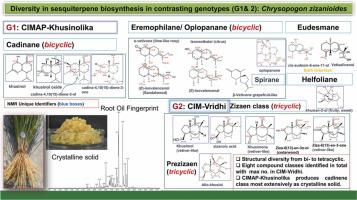Industrial Crops and Products ( IF 5.9 ) Pub Date : 2023-05-11 , DOI: 10.1016/j.indcrop.2023.116798 Ranjana Maurya , Pallavi Yadav , Ram Krishna , Pallavi Kulkarni , Shubhra Rastogi , Soumyajit Mohapatra , Shubham Srivastava , Mohammad Qussen Akhtar , Abhishek Kumar Shukla , Harmesh Singh Chauhan , Rajesh Kumar Verma , Chandan Singh Chanotiya , Ajit Kumar Shasany

|
Vetiver is one of the valued plants in the aromatic world which has been extensively used in fragrances, aromatherapy, and medicines. The essential oils derived from vetiver root portions are mainly responsible for the organoleptic character of the plant. Vetiver essential oil is composed of diverse structural framework biosynthesized by using three isoprene units or sesquitepene leading to a number of bicyclic, tricyclic and tetracylic structures. Sequiterpenoids contribute major proportion to vetiver (Chrysopogon zizanioides) roots. However, the terpene synthases and their role in sesquiterpene biosynthesis in plant have not yet been studied. On the basis of volatile composition, two distinct stable vetiver genotypes viz., ‘CIM-Vridhi’ and ‘CIMAP-Khusinolika’ have been identified in ‘CSIR-CIMAP’ in recent years. Such a unique chemical difference is attributed to the array of structural diversity in sesquiterpenes and their derivatives. The root transcriptome of the two contrasting genotypes ‘CIM-Vridhi’ and ‘CIMAP-Khusinolika’ was carried out and three full length terpene synthase (TPS) genes were analyzed. These synthase genes, CZTPS1, CZTPS2, and CZTPS3 produce multiple sesquiterpenoids and were functionally characterized. In addition, the gene expression studies leading to metabolite biosynthesis in these genotypes were further confirmed by compound isolation and NMR based structural characterization of compounds from each genotypes. A bicyclic cadinane called khusinol identified as unique identifier in ‘CIMAP-Khusinolika’ while khusimol, a tricyclic zizaene dominates the ‘CIM-Vridhi’ oil composition. In conclusion, characterization of unique markers in each genotypes has been well supported by their transcriptomic data. Thus, present study can be utilized to investigate the vetiver terpenoid metabolism and its structure–odor correlations for the production of more potent odor threshold oriented chemicals from this plant.
中文翻译:

印度香根草 (Chrysopogon zizanioides L. Roberty) 中倍半萜多样性的转录组和代谢组分析
香根草是芳香世界中珍贵的植物之一,已广泛用于香料、香薰和药物中。从香根草根部分提取的精油主要负责植物的感官特性。香根草精油由多种结构框架组成,通过使用三个异戊二烯单元或倍半烯生物合成,导致许多双环、三环和四环结构。半萜类化合物对香根草 ( Chrysopogon zizanioides)的贡献很大根。然而,萜烯合酶及其在植物倍半萜烯生物合成中的作用尚未得到研究。近年来,根据挥发性成分,在“CSIR-CIMAP”中鉴定出两种截然不同的稳定香根草基因型,即“CIM-Vridhi”和“CIMAP-Khusinolika”。这种独特的化学差异归因于倍半萜烯及其衍生物的一系列结构多样性。对两种对比基因型 'CIM-Vridhi' 和 'CIMAP-Khusinolika' 的根转录组进行了分析,并分析了三个全长萜烯合酶 (TPS) 基因。这些合酶基因CZTPS1、CZTPS2和CZTPS3产生多种倍半萜类化合物并进行了功能表征。此外,通过化合物分离和基于核磁共振的化合物结构表征进一步证实了这些基因型中导致代谢物生物合成的基因表达研究。一种名为 khusinol 的双环 cadinane 被确定为“CIMAP-Khusinolika”中的唯一标识符,而 khusimol 是一种三环 zizaene,在“CIM-Vridhi”油成分中占主导地位。总之,每个基因型中独特标记的表征得到了转录组数据的充分支持。因此,本研究可用于研究香根草萜类化合物的代谢及其结构-气味相关性,以便从该植物中生产更有效的气味阈值导向化学品。



























 京公网安备 11010802027423号
京公网安备 11010802027423号